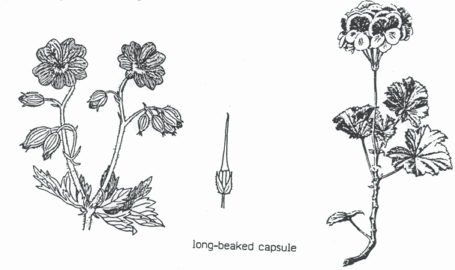Family Description
The Geranium or Cranebill family is a group of herbs or semi-woody dicots consisting of 11 genera and 650 species with wide distribution in both hemispheres. Leaves are palmately veined and usually with alternate arrangement. Flowers are 5-merous, bisexual, with regular symmetry and borne singly or in terminal peduncles. Colors are primarily in shades of red, pink and purple, but other colors occur. The fruit is a long-beaked capsule.
-
The most characteristic features of the family are:
- rotate flowers
- characteristic long-beaked capsule
Important genera belonging to this family include Erodium, Geranium, and Pelargonium.

Geranium ibericum (left) with typical long-beaked capsule and Pelargonium domesticum showing typical palmate veination.
Representative Species
click thumbnail to enlarge |
|||||||
| Geranium sanguineum | Hardy Cranesbill |
|
|||||
| Pelargonium graveolens | Scented Geranium |
|
|||||
| * | Pelargonium x hortorum | Zonal Geranium |
|
||||
| * | Pelargonium peltatum | Ivy-leaved Geranium |
|

